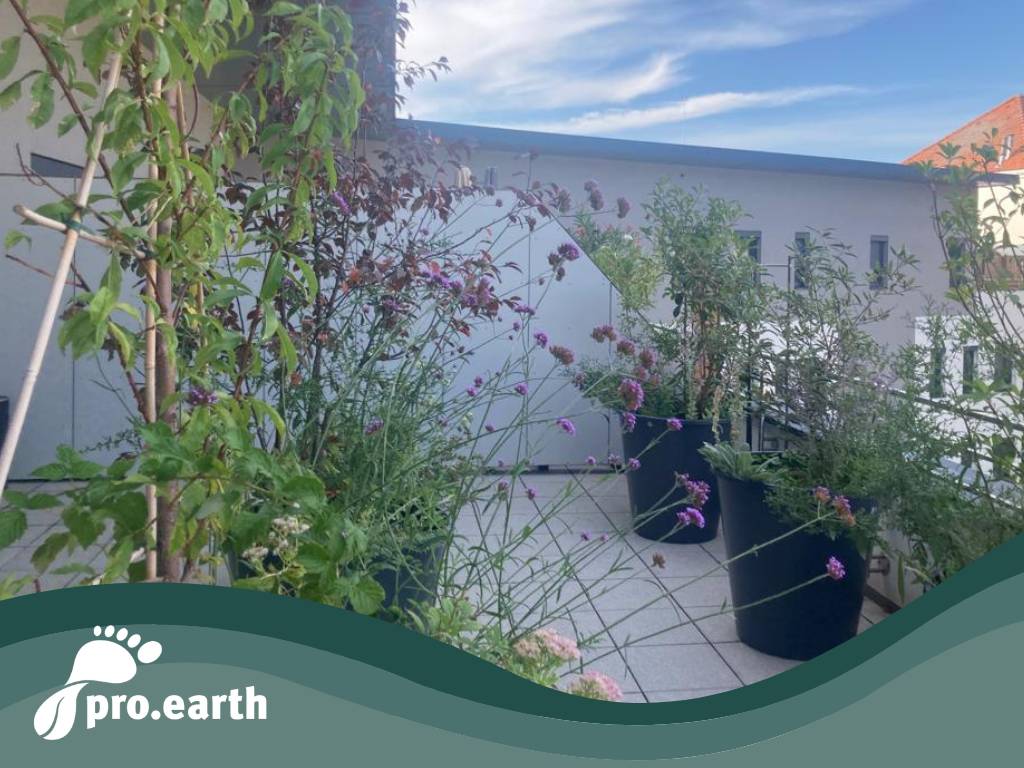Balcony planting for the lazy - Part 1

Having already helped some friends green their terraces, we #Beetschwestern would like to summarize our findings in this article. The basic conditions on balconies and terraces are as follows: Plants are one hundred percent dependent on us humans for both water and nutrients. By choosing the right planters, the right structure in the pots and - very importantly - the right choice of plants, we can turn our balconies into green oases that are also a magnet for insects and yet don't cause us too much work.
How does that work? On the one hand, it depends a bit on your wallet, because high-sophisticated plant pots in large sizes, which include a water storage system, as well as large plants really do cost a lot of money. And for a balcony, you always need quite large pots so that you don't have to constantly water and/or repot plants.
So how did we do it?
1. observe and plan
We studied the course of the sun and determined which parts of the terraces received the most and least sun.
We then drew up a plan tailored to the needs of the residents. Should there be fruit and vegetables on the balcony, how important is privacy protection? Is there a way to collect rainwater? This can save money and is much healthier for plants than tap water. How much weight can the patio bear?
In our experience, you spend about 1/3 of the budget on the plant pots, 1/3 on soil plus substrate and 1/3 on the plants themselves, although we did a lot of research and opted for atypical (cheap) plant pots.
2. decision for plants - Which plants are suitable?
Firstly, the plants should be as insect-friendly as possible, and secondly, they should be able to withstand heat and drought well - and always a good mix, no monocultures, especially not with cherry laurel!
In our experience, hedge plants such as perovskia, loquat, small varieties of lilac, privet (also available as evergreen - for privacy), honeysuckle, roses and grasses are more suitable than perennials, especially for inexperienced gardeners. Small varieties of ornamental apple or raspberries and lavender also do well. They all require a certain potting depth - roses, for example, need a depth of at least 60 cm. We try to create a mixture and still achieve a certain uniformity and aesthetics.
Herbs are also uncomplicated and cope well with dryness and sun. Southern herbs such as oregano and rosemary also thrive well. Or chives.
For those who would also like to have a few perennials on their balcony: Stonecrops, verbena, spurges, spur flowers and globe thistles, also rock roses (not all are hardy!). You can also sow a pot of wildflower seeds. These are usually also drought-resistant (except when germinating).
If you have structures such as a pergola, you can let wild vines, real vines or ivy grow up and add another level to the balcony.
T I P P : Buying plants
It makes a huge difference where you buy the plants. Many DIY stores sell plants (even insect-friendly ones) that have been treated with a highly toxic cocktail of pesticides. These pesticides get to the bees through the pollen.
BUND in Germany found 38 different types of pesticides in 22 ornamental plants, including lavender, phlox, columbine and golden maria, two thirds of which were highly toxic and harmful to bees and even more to humans! Click here for the results.
BUND pesticide expert Corinna Hölzl comments: "The cultivation of ornamental plants has catastrophic effects on the environment and health. A lavender was contaminated with 22 different pesticides, eight of which are harmful to human health, two of which are toxic to bees and two of which were not even approved. Such a product can only be described as illegal hazardous waste."
Even if organic plants and plants from a nursery we trust cost more, they are worth every penny from a health and ecological point of view!
Click here for the 2nd part of our balcony article....






